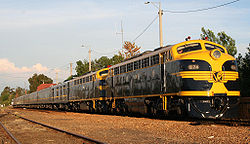Victorian Railways B class (diesel)
| Victorian Railways B Class | |||||||||||||||||||||||||||||||||||||||||||
|---|---|---|---|---|---|---|---|---|---|---|---|---|---|---|---|---|---|---|---|---|---|---|---|---|---|---|---|---|---|---|---|---|---|---|---|---|---|---|---|---|---|---|---|

B74 hauling the 70th anniversary Spirit of Progress in November 2007
|
|||||||||||||||||||||||||||||||||||||||||||
|
|||||||||||||||||||||||||||||||||||||||||||
|
|||||||||||||||||||||||||||||||||||||||||||
|
|||||||||||||||||||||||||||||||||||||||||||
|
|||||||||||||||||||||||||||||||||||||||||||
| Type and origin | |
|---|---|
| Power type | Diesel-electric |
| Builder | Clyde Engineering, Granville |
| Model | Electro Motive Diesel ML2 |
| Build date | 1952-1953 |
| Total produced | 26 |
| Rebuilder | Clyde Engineering, Rosewater |
| Rebuild date | 1984-1985 |
| Number rebuilt | 11 |
| Specifications | |
|---|---|
| Configuration: |
|
| • UIC | Co-Co |
| Gauge |
1,435 mm (4 ft 8 1⁄2 in) standard gauge, 1,600 mm (5 ft 3 in) |
| Length | 18.70 m (61 ft 4 in) |
| Loco weight | 114 t (112 long tons; 126 short tons) |
| Fuel type | Diesel |
| Prime mover | Electro-Motive Diesel 16-567BC |
| RPM range | 950rpm max |
| Engine type | V16 diesel engine |
| Aspiration | Supercharged (Roots Blown) |
| Displacement | Total: 9072ci |
| Generator | Electro-Motive Diesel D12 |
| Traction motors | Electro-Motive Diesel D27 |
| Head end power | Nil |
| Cylinders | 16 |
| Cylinder size | 567ci per cylinder |
| Transmission | Diesel electric |
| MU working | Capable of Multi unit |
| Loco brake | A7EL - Dynamic Brake |
| Train brakes | A7EL |
| Performance figures | |
|---|---|
| Maximum speed | 133 km/h (83 mph) |
| Power output | 1,120 kW (1,500 hp) |
| Tractive effort |
Starting: 267 kN (60,000 lbf) Continuous: 178 kN (40,000 lbf) at 18 km/h (11.2 mph) |
| Career | |
|---|---|
| Operators | Victorian Railways (Vline), West Coast Railway, CFCLA, SSR, CRL, |
| Number in class | 26 |
| Numbers | B60-B85 |
| First run | 14 July 1952 |
| Preserved | B72, B74, B83 |
| Current owner |
CFCL Australia Southern Shorthaul Railroad |
| Disposition | 8 in service, 3 preserved, 9 stored, 6 scrapped |
The B class are a class of diesel locomotives built by Clyde Engineering, Granville for the Victorian Railways in 1952-1953. Ordered and operated by the Victorian Railways, they initiated the dieselisation of the system and saw use on both passenger and freight services, with many remaining in service today, both in preserved and revenue service. Some were rebuilt as the V/Line A class, while others have been scrapped.
The B class were the first mainline diesel locomotives built for the Victorian Railways. The design was based on the successful Electro-Motive Diesel F-unit locomotives with the distinctive bulldog nose. They were unusual in having a streamlined drivers cab at each end.
After World War II the Victorian Railways was run down from years of Depression-era underinvestment and wartime overutilisation. Chief Mechanical Engineer Ahlston traveled the world studying railway rehabilitation. Britain leaned towards steam locomotives, while France was moving towards main line electrification. The United States was more divided, with General Motors' Electro-Motive Division at La Grange, Illinois turning out modern E and F-units diesels. However the EMD units axle load was too heavy for the Victorian tracks, and the Commonwealth Government would not allow the use of foreign currency to purchase United States diesels. As a result the £80 million Operation Phoenix featured steam locomotives and electrification of the Gippsland line, either locally built or imported from the United Kingdom.
...
Wikipedia
